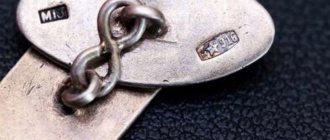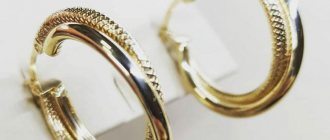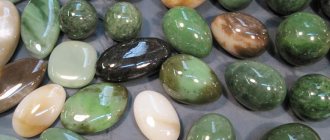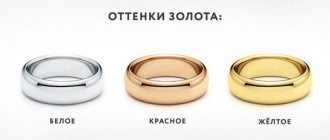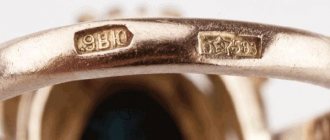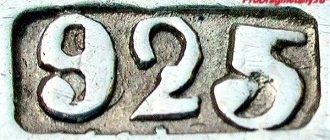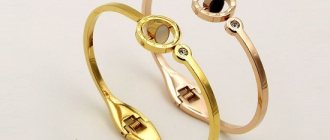Materials such as green gold are increasingly being used to make jewelry. It is an alloy of the usual yellow metal with silver, sometimes diluted with a small amount of copper and other components to obtain different shades.
Such gold is used both for the manufacture of entire jewelry and as a material for decorative inserts in them.
The history of green gold
Man learned about green gold several thousand years before our era.
The ancient peoples of the island of Crete mined this unusual ore, and then made it into jewelry, objects symbolizing religious idols, and much more. The precious green ore found by ancient people was called electrum. The composition included gold, silver (the ratio of which varied from 40 to 10%) and copper.
Green gold was also mined in ancient Lydia. There, wild ore was smelted into coins of the ruler Croesus, which had a yellow color with a greenish tint. Archaeologists date the origin of this money to the 6th century BC.
The idea of artificially recreating a noble green metal came to the minds of scientists already in the 19th century. It was then that all sorts of variations of alloys were developed, giving gold a grassy shade.
History of the alloy
According to historians, the birthplace of green gold is the island of Crete. Around the 1st–2nd millennium BC, they learned how to produce such an alloy. At that time it was given the name electrum. Green gold was an alloy of gold and silver and was used to make a variety of jewelry and religious objects.
Green gold ring
Electrum is also a type of native gold that was common in the Mediterranean. Its silver content reached 10–40%, and copper was also present in small quantities. Of the products made in ancient times from this alloy, the coins of King Croesus have reached us, as well as some elements of Scythian jewelry, for example, the legendary pectoral.
What does it represent?
The only clear answer is this: it is an alloy of 750 or 585 gold with other metals that give it a greenish tint. There can be many such metals, therefore, in order to be called gold and be used in jewelry, they must meet certain requirements:
- the alloy must be inert, not oxidize in air and not react with substances, with a few exceptions;
- be flexible and also withstand certain types of stress that create internal stress, such as stretching and torsion;
- have hardness so that the edges remain polished;
- do not cause allergies.
These conditions immediately eliminate the two metals that give gold its truly green color: cadmium and rubidium. Rubidium is not suitable due to its chemical properties. For example, when it reacts with oxygen, it flares up. When alloyed with gold, it produces a metal that is too brittle to be used in jewelry. In addition, it can sometimes cause irritation upon contact with the skin.
Cadmium is not suitable due to its toxicity, therefore in Russia and the European Union it is prohibited to use it as an alloying metal. It should be noted that in some other countries it is legal to use cadmium to make jewelry. It is a silvery-white metal that causes a decrease in the melting point of metals and is often used in chemical reactions.
When inhaling vapors, a person can receive such a level of toxic substances that can even lead to death. When used in jewelry, it poses a greater danger when making jewelry than when wearing it. However, cadmium also accumulates in the body and is a carcinogen.
General requirements for a group of metalloids
Since there are many variations, green gold has its own number of restrictions and requirements for the quality of raw materials. First of all, we are talking about human safety, therefore, from the main types used in jewelry, those that cause allergies and react with oxygen or other substances from the environment are excluded. Secondly, it is very important how the metal behaves in everyday use. It must be flexible enough to bend and be subject to torsion and decorative curves, but hard and durable enough to hold the shape of the polish. Alloys that do not comply with these points can be used in small quantities as an external insert for a particular object.
You can also look at green gold in photographs in various catalogues, but only “live” can you notice the beauty of the shimmer and the originality of the material. In addition to 750, the use of 585 is also allowed; you can verify the number on the jewelry stamp. If we take the carat as a unit of measurement, the indicators can be 10, 12, 14, 15, 18. To determine the price, gold is measured in grams.
Green gold properties and characteristics
Gold acquires grassy tones due to inclusions of the following metals:
- Silver.
- Cadmium.
- Copper.
- Zinc.
- Potassium.
- Rubidium.
- Nickel.
The color saturation of green gold directly depends on the ligature used. The metal gets its light greenish tint from alloys: silver, potassium, nickel, zinc and copper. Additions of rubidium and cadmium give the gold a rich, bright green tone.
Despite the fact that green gold is very elegant and looks great in combination with any precious mineral, not all of its alloys are safe for the human body. So the precious metal, in combination with cadmium, is very toxic. It is not used in the jewelry industry in the Russian Federation and in most European countries.
There is no jewelry made of rich green gold in our country. For example, rubidium, which gives the alloy a bright grassy tint, turns it into a very fragile material that is not practical for daily wear.
A green precious metal, it is characterized as brittle, crumbly and difficult to process. For the most part, it is used by jewelers as additional decorations to the main product. The strongest metal is obtained in combination with silver, and only with strict adherence to proportions.
Composition characteristics and properties
According to Russian standards, a pure green precious metal is an alloy containing 25–27% silver and 73–75% gold. However, several other compositions are also allowed, which differ in color saturation:
- ZlSr 585-415: 58.5% gold, 41.5% silver;
- ZlSrM 585-300: 58.5% gold, 30.0% silver, 11.5% copper;
- ZlSr 750-250: 75.0% gold, 25% silver;
- ZlSrM 750-150: 75.0% gold, 15% silver, 10% copper.
Compound
Standard green gold contains about 73-75% of this metal and 25-27% of silver, this is its “purest” composition. In the Russian Federation, there are GOST standards that allow several options for obtaining green gold. The result is not a saturated color, but a kind of yellowish-green tint that shimmers in the light.
In countries where the use of cadmium is permitted, it is added in the following proportions:
- 23% copper and 2% cadmium. This alloy turns out to be light.
- When adding 15% silver, 6% copper and 4% cadmium to the same amount of base metal, the color turns out dark.
Russian GOST regulates four grades of green gold:
- ZlSr 585-415, contains 41–41.5% silver.
- ZlSrM 585-300, contains 29.5–30.5% silver, as well as copper.
- ZlSr 750-250, contains 24.5–25.5% silver.
- ZlSrM 750-150 contains 14.5–15.5% silver, the rest is copper.
Alloys in which copper is present have a greenish-yellow color; if silver alone acts as an alloy, gold is saturated green.
About colors and samples
Gold is green in color, can be a rich deep shade or a delicate, light one. Jewelers advise giving preference to products in a light green color, since this tone gives the jewelry a charming appearance.
Jewelry experts claim that the bottle color in the alloy appears due to the influence of the following components:
- Silver
- Copper
- Nickel
- Rubidium
- Cadmium
Moreover, rubidium and cadmium play the main role in coloring. However, the first component makes the precious alloy brittle, and the second is highly toxic. If somewhere in Guatemala cadmium is added to a green gold alloy, then in the Russian Federation this is prohibited by law. Jewelers, in order not to break the law, add silver to the precious alloy. Of course, this component does not add saturation to the shade, but the gold turns out to be a beautiful color and, most importantly, absolutely safe.
Today there are two types of bottle-colored gold - 585 and 750. Both types of precious metal are used to make:
- Sereg,
- Medallions,
- Coulombs,
- Broshek,
- Chains,
- Bracelets
- Other jewelry.
Green gold color
The color of green gold can be either light or rich. Most often, in the windows of jewelry stores and in online catalogues, gold in light green tones predominates. The soft green color of such gold jewelry does not lose its natural brightness, so it looks especially charming.
Men's green gold ring with diamonds
Women's ring made of green gold with multi-colored stones
It is worth understanding that photos in jewelry catalogs cannot convey the real color of green gold. Only “live” can you appreciate the jewelry and notice all the subtleties of such an original color of the jewelry. When choosing green gold jewelry, it is best to try them on. Only in motion can you see the whole range of gold color of the jewelry and decide to buy it.
Basic shades
The shade of electrum can vary, but light green tones still predominate in jewelry stores. They look as natural and attractive as possible for most buyers.
The presence of copper in the composition provides a combination of yellow and green colors. The more impurities, the more clearly the contrast is visible.
However, the use of copper also has negative sides. Alloys based on the yellow noble metal with silver themselves have low strength and ductility.
With the addition of copper, these indicators deteriorate even more. As a result, the decoration becomes fragile and crumbles.
Careful care and storage of green gold jewelry
Electrum is more fragile than classic yellow gold products. It requires special care. It is not advisable to wear it all the time, since it will be almost impossible to protect the metal from negative external influences (falls, shocks, strong compression).
After removing the jewelry, it is recommended to wipe the product with a soft, dry cloth. Clean electrum exclusively using a weak soap solution or ammonia. Store jewelry in a special case, soft bag or box.
Storing gold jewelry
How to identify toxic gold.
For many years, gold-toned products were made using toxic cadmium. Its share in jewelry was so small that the harmful effect on the body appeared only after many years of wearing the products.
Only a few years after the release of the first “green” jewelry, governments around the world drew attention to the dangers of such products and limited the production of jewelry that contained cadmium.
In Russia, restrictions on “green” gold alloys, with a ban on the use of cadmium, came only in 2000.
Safe green gold in the Russian Federation is designated by the following grades:
· ZlSr 585-415
(pronounced green color of the product);
· ZlSrM 585-300
(yellow gold with a faint green tint);
If the description of products with a characteristic shade does not contain similar information about the composition of metals, then such jewelry may be made with impurities of hazardous metals.
In Soviet Union
green gold had a similar marking, to which the designations ZlSrM 583-300 and ZlSr 583-417 were added for products of 583 standard (nowadays such a standard is not installed on jewelry).
Foreign-made green gold
and can still be manufactured
using toxic metals.
Some countries of the world have not yet abandoned such alloys. The only exceptions are products from European Union countries, where cadmium in jewelry is prohibited.
I really hope that the article was useful to you. You can read more about the properties, hallmarks and price per gram of green gold here.
Top 3 gold cleaning methods
Signs that jewelry is oxidizing cannot be missed. But there are several ways that will help you safely return the product to its original appearance at home.
- Cleaning with ammonia. The most common and easiest way. You will need a deep glass container into which you pour a glass of water. To make the powder dissolve better, use warm, but not hot, water. Pour a tablespoon of washing powder or liquid soap and a teaspoon of ammonia into the container. The sequence must be maintained: first the powder, and then the ammonia solution. Decorations are immersed in the resulting mixture for two hours. After this, they are washed with warm running water and dried with a soft waffle towel.
- Dishwashing liquid . Pour a glass of water into a small saucepan or stewpan, add a teaspoon of the product, place a soft cloth on the bottom and place things that have begun to oxidize on it. Boil soapy water together with jewelry for 7-10 minutes, then rinse and dry the jewelry.
- Liquid soap, ammonia and peroxide. Another effective mixture that allows you to quickly and effectively get rid of dirty deposits on jewelry at home. Dissolve a teaspoon of ammonia, soap and peroxide in a glass of warm water. It is enough to place the jewelry in the resulting solution for just 10 minutes. After this, the products are washed and dried.
Unfortunately, there is no way to prevent your favorite ring or chain from oxidizing.
The fastest way
Take a piece of flannel, fleece, or any soft cloth, and then lightly wipe the item with it. The method is great for rings and earrings. By doing this procedure every day, you will not only save time on cleaning, but also extend the life of the products.
Most effective
In addition to ammonia mixtures, effective ones include specialized devices for home cleaning of oxidizing jewelry and costume jewelry. These are ultrasonic devices, effervescent tablets, special impregnations and wipes. However, when choosing impregnation, you need to pay attention to what kind of gold it is suitable for.
The cheapest
If it is not possible to look for specialized means or take jewelry to a workshop, use available means. In addition to the well-known soda, salt and vinegar, Coca-Cola is used, which also contains acids that break down plaque. The products are soaked in a glass of drink for one hour, and then washed with running water and wiped with a cloth.
Blue, green and other atypical shades of gold
For a long time, residents of our country understood gold as only one alloy: red. Any other shade caused bewilderment and comments like: “Is this really gold? It's a fake copy!"
But the years passed, and a wave of fashion for white, yellow, lemon and rose gold poured into the Russian market. Nowadays you won’t surprise anyone with jewelry made from these metals.
But jewelers know how to give surprises. Jewelry houses with big names make jewelry from gold of the most atypical shades.
Brown gold
Its creator is considered to be jeweler Fawaz Gruosi, founder of the de Grisogono brand. He is known to the world as a great inventor and experimenter. And, like many creators, he prefers to hide his technology for obtaining a chocolate shade of gold.
It is assumed that this shade appears by combining red and rose gold of various samples. The main “helpers” are nickel, copper, manganese, and iron. Or brown color is obtained by combining gold with copper, silver and palladium.
This shade of gold is most often found in watch parts; it is rarely used in the jewelry industry.
Purple gold
This shade, also called amethyst and lavender, is obtained by mixing gold with aluminum. The alloy itself is so weak that it is used only as a coating for jewelry.
Blue gold
Another shade of gold that is practically not used in jewelry is blue.
It is extremely difficult to obtain this color; technologies are known: either mixing gold with indium, or with cobalt, or with steel.
Also, blue gold, like black gold, is obtained using rhodium plating.
Black gold
You can get this shade by mixing pure gold with chromium and cobalt. But the manufacturing process is so complex that black gold of decent quality is rarely found. Therefore, jewelers resorted to a trick and offered customers white gold coated with black rhodium as black gold. It is important that the ring has texture. The rhodium plating quickly wears off from the smooth surface of the ring and the ring becomes white.
Green gold hallmark
Jewelry made from precious green metal is mostly 750 or 585. Alloys included in the alloy transform into a liquid state at different temperatures. Consequently, the alloy manufacturing process takes place in several steps.
In the karat system, precious metals are assigned markers: 18, 15, 14, 12 and 10.
The standards of the Russian Federation regulate four types of green gold, which are represented by the following alloys:
- 585 standard: gold 58.5%, silver 41.5%. Has a green color.
- 585 standard: gold 58.5%, silver 29.5%, copper 12%. It has a yellow color with a green tint.
- 750 standard: gold 75.5%, silver 24.5%. Has a green color.
- 750 standard: gold 75.5%, silver 14.5%, copper 10%. It has a yellow color with a green tint.
In Russia, both grades of green gold - 585 and 750 - are used only in the jewelry industry. 585 standard is used exclusively in the manufacture of jewelry: pendants, earrings, chains, bracelets, watches, cufflinks, tie clips, brooches and much more. 750 standard is intended not only for the manufacture of jewelry, but also souvenirs. Also great for precious items with enamel coating.
What is the purity of green gold?
In our country, electrum is presented in two hallmarks: 585 and 750. Gold leaf, used for gilding, belongs to a separate category. It is marked with 960 breakdown.
More about products
In Guatemala, a spice called cardamom is very popular. This plant is even called green gold, since exports bring the lion's share of profits to Guatemalans. In our country, green gold is a special alloy of precious material. And although, due to stereotypical thinking, products made from this metal are not very popular, jewelers still offer an assortment of jewelry with a green tint.
Green gold ring with stone
A green gold ring framed with green stones looks elegant and original. Jewelers offer rings with green amethysts, agates, and emeralds. In eastern countries, bottle-colored agate is considered a symbol of masculinity and bravery. Thanks to the chlorides that make up the agate stone, the shade of the mineral changes from light to rich.
There is no emerald-colored amethyst in nature, but after chemical treatment, the natural purple mineral acquires a green color. The best settings for this stone are traditional yellow, white or bottle-colored gold and silver. Amethyst rings are recommended to be given to men as a talisman against drunkenness. Green amethyst in gold looks amazing, which is confirmed by the photo.
If you want to protect a loved one from vision impairment, give a green gold bracelet decorated with emeralds. For a long time, this stone was considered healing. The unparalleled beauty and healing properties make this mineral one of the most sought after. And in combination with green gold, emerald looks even more attractive. Gold in green stones looks mesmerizing, as we can see by looking at the photo.
Jewelry requirements
Processing green gold requires high-level craftsmanship, patient work, knowledge and experience from the jeweler. That is why jewelers have certain requirements for this capricious alloy.
First of all, the metal must be passive to chemical reactions with air and other substances that are easily accessible to the average person in everyday life. For example, gold in combination with rubidium or cadmium has a negative impact on human health and can even leave a chemical burn on the skin.
Green metal must have sufficient ductility and resistance to mechanical stress. Otherwise, the jewelry will turn out to be very short-lived. The alloy must also have sufficient hardness to successfully undergo jewelry processing.
Very rarely, jewelers can use nickel as a ligature to obtain a precious green alloy. This metal simultaneously gives gold the strength needed for processing and a grassy tone. But when wearing such jewelry every day, there is a small percentage of the likelihood of allergic reactions.
Decorations
Such gold is not in great demand in our country. The reason lies in stereotypical thinking. Residents of the post-Soviet space often have the opinion that this noble metal should be yellow or have a slightly reddish tint. Other colors, including even white, are associated with jewelry. This is especially due to the fact that not everyone around will be able to understand that the product is made of gold, which, as it were, reduces the status of its owner.
A variety of jewelry is made from it, using the metal both to make the entire product and in the form of small inserts. Unlike other unusual flowers, it is malleable and malleable to produce a wide variety of shapes. If green gold is used, then it is used only as inserts, since its characteristics are low; in addition, it can be toxic or cause allergies.
Often on the jewelry market you can find jewelry that is a combination of two or more alloys. Pairing regular gold with an alloy or intermetallic of a different color, especially those that contrast with each other, makes jewelry brighter and more attractive. Since such a process is costly and more labor-intensive, jewelry is more expensive.
The price of gold jewelry corresponds to that with a green tint, of course, if we are talking about alloys that are made in accordance with GOST standards. If other metals are used or the production technology is different, then the price increases accordingly. Often jewelry is complemented with natural stones such as diamond, emerald, Dresden diamond or demantoid. Such jewelry can be much more expensive due to the high cost of these stones.
Green gold looks great in jewelry of any kind, earrings, bracelets, rings and others. It makes the image unusual, although, unfortunately, it is not suitable for everyone and not for any color of clothing. But the jewelry is rare and has its own zest. Buying green gold is recommended for people who love everything unusual, but at the same time high-quality.
Use of metal
Jewelers use this material to make a wide variety of jewelry: rings, bracelets, pendants, earrings, brooches, clips, hair accessories, cufflinks, necklaces and chains.
18k green gold is also used as the basis for souvenirs, awards, orders, corporate badges and enamel products. Unlike many other types of colored gold, it can be used as a base for jewelry. Jewelry made from this unusual alloy looks very exotic and seems to glow with a soft greenish light.
Unfortunately, only dull versions of electrum can be used to create an entire ring or bracelet. Mixtures with a deep green tint are usually too brittle or toxic to be useful. Nevertheless, inserts, overlays and individual elements of jewelry are sometimes made from them.
The combination of several types of green gold with each other, as well as their combination with other alloys and intermetallic compounds of different shades, looks very beautiful. The contrast between the two metals makes the jewelry unusual, and the harmonious combination of colors gives it tenderness. At the same time, a product made of such gold will almost never look too bright or vulgar, unlike classic yellow jewelry, which is quite easy to “overload”.
The noble green metal also goes well with many precious, semi-precious and decorative stones: from emeralds and sapphires to quartz and crystal. They can be used either as small inserts or as the main element, the beauty of which will be emphasized by a more modest-looking metal.
Plant and floral motifs are very popular in electrum products. Often in jewelry you can see inserts in the form of leaves, stems, tree crowns, vines, twigs, grapes, and so on. But there are also more austere works without any additional decorations.
Green gold is a rather rare and unusual material , which is why mass production of jewelry made from it is rare. Most of the jewelry is unique handicrafts by various craftsmen, which adds even more value and exoticism to it. However, an inexperienced person can easily mistake them for jewelry, which is the main reason for the low popularity of the alloy.
Gold price
The price of this material is approximately the same as the cost of other alloys of 750 and 585 gold. According to the exchange rate of the National Bank of Russia, it is about 2.5-3 thousand rubles per gram and varies depending on the composition of impurities and the general situation on the market. In jewelry, the price of green gold will be slightly higher than yellow, white or red, since it is less common and more difficult to work with.
As part of rings, chains, pendants and bracelets, the cost of the alloy ranges from 6-7 thousand rubles per gram and more. But it is worth remembering that the price of jewelry depends not only on the weight of the metal, but also on the complexity of the work and the required qualifications of the jeweler. Gemstones or inclusions of other materials, such as platinum, can also add value.
In Moscow and Russia, it is quite difficult to find products made of green gold: the material is not very popular among the population and it is not possible to sell it profitably.
Green gold jewelry
In the Russian Federation, at this point in time, green gold still remains unrecognized by the consumer. Russian people are very accustomed to the idea that gold is necessarily a yellow or reddish color. Many of our compatriots believe that jewelry made of multi-colored gold resembles ordinary costume jewelry in its appearance. But such an opinion is far from the truth and completely goes against modern trends in jewelry fashion.
This noble metal with a light grassy tint is used by skilled jewelers to make chains, bracelets, pendants, earrings, rings, brooches, cufflinks and tie clips. Metal of a bright green tone, due to its fragility, is partially included in jewelry. It is used to make decorative inserts in earrings, rings, pendants and much more.
The alloy is green in color and has an exceptional quality that blends harmoniously with any metal. So, in company with gold of a different shade, it turns jewelry into a real embodiment of sophistication and beauty. However, making such products costs a lot of work for the craftsman. That is why their price is much higher than that of jewelry made from a homogeneous metal.
Reviews
Caroline:
“My husband gave me a set of green gold jewelry for our wedding anniversary. Indescribable beauty. I wear it on holidays, and the effect is always stunning.”
Victoria:
“They gave me a green bracelet and earrings. Until they explained what it was, I thought it was ordinary jewelry.”
Anya:
“I already have a collection of green gold jewelry. Of course, they need good care (so as not to knock or spoil them with some kind of chemical), but it’s worth it.”
Combination of white and green gold
Interest in jewelry made from different types of precious materials increases every year. For example, a bracelet made of white gold and green gold looks elegant. Previously, jewelers used nickel to produce white gold. But, later it was found that this component causes allergic reactions. Therefore, nickel was replaced by palladium, which gives the metal softness. Thanks to its softness, products made from this material are delicate and elegant. Well, in combination with green gold, the white precious metal looks even more magnificent.
Ways to clean blackened gold at home
It is advisable to clean your jewelry regularly and carefully. This will prevent the jewelry from oxidizing and will maintain its attractive appearance for a long time. But don’t be upset if the product has already turned black. Powder, detergent and even salt will help restore something dear to your heart.
If there is no need to rush, it is enough to soak oxidizing precious jewelry overnight in a solution of soda or table salt. In the morning, they are washed with warm water, lightly dried with a soft cloth and wiped with a lint-free towel.
White gold
In some cases, cleaning white gold at home is strictly prohibited or impossible. For example, yellowed jewelry can only be restored to its original appearance in a galvanic workshop. Blackened white gold is restored by polishing, but at home it is almost impossible to carefully polish the product without disturbing the plating.
Differences from fakes
In the Russian Federation, under the guise of noble metal, they very often try to sell fakes at an inflated price. This is due to the fact that the average consumer is poorly familiar with the qualities and properties of this type of colored gold, and therefore is not able to recognize deception. Statistics say that approximately 4 out of 10 products are fakes, so you need to buy green gold with extreme caution. To distinguish real material from a fake, you should pay attention to the following details:
- Color. Jewelry that is dominated by rich and bright shades of green is either fake or made from alloys with toxic impurities, so you shouldn’t buy them. Classic electrum has a light yellow-greenish tint, the saturation of which depends on the content of silver and copper.
- Marking. The product must have a stamp mark indicating 585 or 750. If it is not there, then the data on the material used has not been verified or confirmed by anyone.
- Impact resistance. Fake gold tarnishes very quickly when exposed to alcohol, iodine or even salt water, while real gold does not interact with these substances in any way.
- Reaction to a magnet. The alloy should not contain impurities of iron, steel and other similar materials, therefore even a slight attraction to a magnet indicates that it is a fake.
- Condition of moving parts. For items made from fake gold, they wear out very quickly and lose color, so before purchasing, you should definitely look at all their clasps, clasps, hanging parts and links.
- Weight. Usually fake products are lighter than genuine ones. However, it will be difficult for an ordinary buyer without a jewelry scale to notice the difference unless we are talking about a whole bar or a very large piece of jewelry.
It is best to buy green gold from trusted manufacturers who enjoy the trust of customers. After purchasing, it is advisable to submit the metal for examination to find out the exact composition of the alloy. Only experienced jewelers who are already familiar with its properties and qualities should be trusted to make jewelry from this expensive material.
How to recognize a fake
Modern statistics show that in 100% of cases of purchasing gold products, 40% of them turn out to be fake. This noble metal has a high cost, is an excellent investment and always looks impressive as a decoration. Therefore, in case of fraud, there are enough reasons for disappointment. If you doubt the authenticity of a product, it is better to have it examined by a certified jeweler. However, you can check whether your gold is real at home.
First of all, check the sample stamp. For green gold, it should be marked "750" or "585". Then examine the joints of the product parts. On fakes, the gilding in moving places wears off very quickly.
A magnet is perfect for checking the authenticity of grass-colored gold. The alloy must not react in any way to a magnetic field. You can also try a gold piece for a “bite”. Teeth imprints will definitely remain on real precious metal.
The latest developments in green gold production
More recently, English scientists have discovered a method for making green gold without resorting to alloys. Optical research played a significant role in this discovery.
During the production of green metal, its surface is given a relief structure. The greater the ratio of the area of the ingot and the number of its irregularities, the more the reflective and refractive characteristics of the precious metal change. Depending on the surface structure of gold, a person begins to see it as green, blue, red or pink.
This technology is not yet perfect, and is currently only applicable to large-sized gold products or bars. But when processing metal with a large area, it really works wonders. Using this technology, gold can acquire not only a uniform color of any shade, but also become multi-colored or patterned.
Why does the finger under the wedding ring turn black?
At a time when people believed in omens, seeing a black mark from a ring was considered a very bad sign. Today no one believes in such signs, and the blackness is explained by the simple desire of jewelry stores to give their goods a more attractive appearance. For this purpose, products (especially rings) are rubbed with a special polishing paste.
It is this that remains on the skin over time in the form of dark spots, and there is no talk of gold oxidizing.
